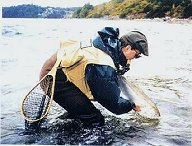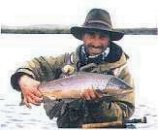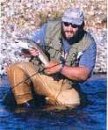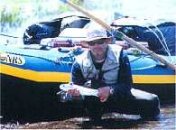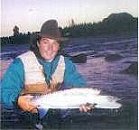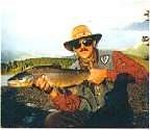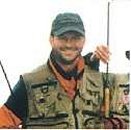|
Placed at the heart of Nahuel Huapi National Park, in cozy Villa
la Angostura mountain village, this program offers it all:
world-class fly fishing conditions, a reverse season (November
to April), the mild weather of the northern Patagonia, removed
fishing spots, great food and service, and flexibility to
ensure great results, whether you are looking for brookies,
rainbow or brown trout monsters in a typical Patagonian river
or spring creek.
Villa la Angostura stands on the shores of the amazing Nahuel
Huapi lake, surrounded by stunning mountains, deep blue lakes,
rivers, waterfalls, rainforests, alpine valleys, steep
glaciers and peaks as high as 7500 ft.(2300 mts). It’s only
50 miles (80 km) away from San Carlos de Bariloche tourist
town and in the middle of popular Seven Lakes Scenic Route.It
is, also, a perfect spot to bring non-fisher companions along,
plenty of sightseeing and adventure travel opportunities
abound. We’ll be glad to provide programs for them as well.
6 days / 7 nights Program includes:
Rates (in US$)
Rates per person based on double occupancy
Discounts for groups of 6 or more. The Fishing Season
The Weather
The Fishing Introduced to the region by angling enthusiasts from Europe, brown, rainbow and brook trout quickly established permanent breeding populations, and are now considered wild. Prospering on the abundance of aquatic insects and crustaceans, you can be sure of finding stretches of virgin water where trout have never encounter artificial fly before. All three species have grown impressively in both size and number to produce truly world-class fly-fishing conditions. Expect to land rainbows, browns and brooks from 7 inches to 15 pounds. Shallow riffles, fast runs, deep pools, undercut banks, isolated channels and deadfall structures offer a variety of challenges for every fly-fisher taste.
During November and December, with high water levels in rivers, you'll find many big rainbows and browns still on the move back to lakes. Chances to catch a Trophy fish are good. These are long days on easy wadeable rivers. It’s dry fly time. Caddis and mayfly hatches put trout on the move almost everywhere. March and April is the most quiet and scenic time of the year, as reds, greens and yellows blend on the mountains and riverbanks. Low water levels and easy wading invite you to use the lightest possible tackle on rainbows and big browns, which are entering the rivers from the lakes to spawn. At this time of the year, you can most probably fish even the most popular rivers without spotting any other angler for days.
Our staff includes nine experienced, professional and native
Fly Fishing Guides who love what they do, who are equipped
with the most advanced gear in terms of drift boats, pontoon
boats, engine boats, off-road vehicles and so on.
Rods and Flies: what to bring During spring and early summer a light rod for smaller waters and a heavier rod for bigger waters and windy days are recommended. An ideal combination would be a 3-weight rod with a floating line and a 6-weight with a floating line and class V sinking shooting head. If you prefer to travel light, then a 5-weight rod coupled with a floating line and fast sinking shooting head will be a good overall choice. From mid summer to fall, a 4-weight rod with both a floating line and a fast sinking shooting head will do fine in almost all waters. To better enjoy the different types of water, bring a 2-weight road with floating line and a 5-weight rod with floating line and shooting taper. The streamers box should include Wooly Buggers in black, olive and brown (size 4-10), Rabbits in cinnamon and white (size 2-8), Marabou Muddlers in black and natural brown (size 2-8), and black and brown Grizzly Matukas in small sizes from 8 to 14. The most effective nymphs are the Prince Nymph (size 8-14), Hare's Ear in natural, brown and black (size 10-16), Pheasant Tail (size 12-20) and big attractor patterns such as the Wooly Worm and the Yukbug in sizes 2 to 8. For dry fly, include some fast waters dries such as the Humpy, in red and green (size 10-14), Western Adams (size 10-16), Stimulators and Royal Wulffs (size 10-14). For slower water, a series of thorax dries tied in rusty brown, olive and cream in sizes 14-18 will do the trick. Caddis patterns in olive and black (size 12-18). Also, a selection of hoppers, foam spiders and beetles, ants and a few gray scuds are necessary. We will provide the special match the hatch flies on the stream. The Land Patagonia lies at the southernmost tip of the southern hemisphere. It encompasses extensive areas of incomparable wilderness. It is framed by the Andes Range, on the west, and the South Atlantic Ocean, on the east, offering a great diversity of landscapes, from snow-crested peaks amidst broad glacial fields to deserts, to dense ancient forest and stunning seascapes. The variety and sheer number of animals enrich the spectacle of the Patagonian landscapes.
Cold water glacier lakes, in which many of the headwaters for most of the areas famous crystal clear rivers begin, spot this region. Many of these rivers are interconnected, forming a system that provides hundreds of miles of fishable waters. The snow-capped mountains are covered with ancient species of "alerces", "lengas" and "coihues" forests in the west, giving way to the "cipres" as you move to the eastern portion of the mountains, and finally disappearing into the desert further east. Riverbanks are covered with willows, which have a significant role in the overall river and trout ecosystem, protecting them from erosion and giving refuge to numerous trout and their food supply. Foothills are where most of your fishing will take place. It resembles eastern Montana, Wyoming and Idaho, only with reversed seasons. The Patagonian portion of the Andes includes the southernmost five Argentine provinces of Neuquen, Rio Negro, Chubut, Santa Cruz and Tierra del Fuego. The length of this region is over 1250 miles /2000 km. How to get there Fly into Ezeiza International Airport (EZE), located in Buenos Aires, Argentina and take a connecting flight to San Carlos de Bariloche domestic Airport. United Airlines has daily non-stop flights from New York and Miami. American Airlines flies non-stop from Miami, New York, Dallas, and Los Angeles. The international flight is usually an overnight flight that takes from 8 hours (leaving from Miami) to 11 hours (from NY). Bariloche stands 995 miles (1600 km) southwest of Buenos Aires on the Andes range. It’s a 2 hour flight. We will be glad to help you with any travel
arrangement, either domestic or international, you may need.
|
||||||||||||||||||||||||||||||||||||||||||||||||||||||||||||||
Services - Rates - Season - Weather - Fishing - Guides - Rods and Flies - Land - How to get there





